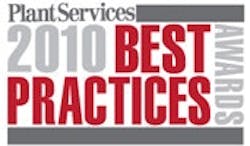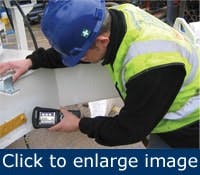Best Practices Awards: Management A mobile asset management solution features RFID technology
The Plant Services Best Practices Awards recognize management techniques, work processes, and product and service implementations that exemplify the definition of a Best Practice according to the Society of Maintenance and Reliability Professionals (SMRP): “A process, technique or innovative use of resources that has a proven record of success in providing significant improvement in cost, schedule, quality, performance, safety, environment or other measurable factors that impact the health of an organization.”
Entries must demonstrate how to implement a best practice, show the potential payoffs in both qualitative and quantitative terms, and provide inspiration for those who must overcome cultural inertia and make effective changes. Entries may be submitted by plant personnel, vendors, engineering firms, consultants or anyone who is familiar with the application and has permission to make it public knowledge. Our categories also include Equipment, Reliability and Energy Efficiency, but this round’s focus is on Management.
Every contender offered an impressive management practice that can increase productivity, improve efficiency or reduce costs. Judging criteria included percentage reductions or cost savings, return on investment and broadness of applicability, with recognition given for innovation and creativity.
The winning practice was submitted by Matthew Preston, director, Byrne Group PLC, and Kate James, marketing manager, 4H Solutions, together with support from COINS. The concept of using RFID to track assets, tools and materials is no longer new, but Byrne overcame significant challenges by implementing it on a wide variety of items, many of which are mobile, over a large geographical area. Add in the fact that they tagged virtually everything and everyone, and the challenge of a long history of doing things the old-fashioned way, and Byrne Group’s successful implementation won the votes of our judges to become this round’s Best Practice in Management.
Winner: RFID empowers mobile asset management
Taming tools and materials promises five-year cash flow of $350,000
With more than 1,300 items of plant, tooling and equipment, UK construction services company Byrne Group set about addressing deficiencies in its processes to improve both profitability and customer service. Working in collaboration with 4hSolutions (www.4hsolutions.com) and COINS (www.coins-global.com), it developed a way to address the management and control of Byrne’s assets.
[pullquote]The Byrne Group had already established a consolidation center in Mitcham, South London, and was one of the first in the industry to do so. The seven-acre facility is a hub that provides plant and materials, and warehouse and distribution facilities to most of its construction sites. With more than 1,300 pieces of equipment, the asset management function was less than stellar. Asset tracking for portable appliance testing (PAT) and other maintenance processes was performed manually and was labor-intensive. Each year, more than 3,200 individual job cards were processed at a cost of about £33 ($50) each. There was no effective theft deterrent, resulting in about £100,000 ($153,000) worth of tools lost or stolen each year. In addition, the Mitcham site lacked a robust method for tracking tools once stores issued them. There was no accurate way to know what was where, and when or if it had been returned.
The situation with requisitions wasn’t much better. It was paper-based via fax and telephone, which in requisitions being misplaced or misinterpreted. Every engineer and foreman had their own way of describing what item they needed, which then required an interpretation back at the consolidation center. And consumables — timber, fuel and stock items such as personal protective equipment and signs — showed no record of ever having been requisitioned.
Tagged assets can be instantly scanned and identified using handheld computers.
Combining the COINS Plant Manager module to automate the issue and return of Byrne Group’s plant, stock and equipment with Assettagz’s radio frequency identification (RFID) technology made it easy to manage, track and get visibility of these assets.
Byrne approached the project in two phases, the first of which was to get visibility and take control of its assets by building an asset register. Byrne required one full year to tag its plant, tools and equipment to populate and maintain an accurate asset register using Assettagz.
A variety of RFID tags were used. Bins containing stock items were labeled with plastic credit-card-sized tags. Tools got glass tags. Lifting gear had molded plastic tags attached with steel cable. On August 1, 2008, Byrne issued Assettagz RFID-enabled ID cards for every staff member at Mitcham. These ID cards are used in conjunction with handheld computers to track any equipment issued to the staff.
Phase two was to improve the plant and stock procurement process via the COINS e-catalog. Byrne used COINS Plant Manager to catalog its plant and stock to fill an e-catalog.
Byrne Group’s new integrated requisition and asset management process featured several useful improvements. The Hire Desk in the consolidation center processes requests using COINS. COINS generates the pick lists, which the Assettagz Web application passes to the RFID-enabled handheld computers in stores. Stores use Assettagz to identify and pick the required items using handheld computers.
Stores also use Assettagz to record the results of inspections and to ensure that certification is up-to-date. Examples are portable appliance testing for electrical items and lifting equipment inspections for lifting equipment. After picking, a dispatch is generated, the “on-hire” is confirmed and a delivery note is generated.
The logistics department collects material from the consolidation center and delivers it to where it’s needed. The site staff uses RFID-enabled ID cards to assign equipment in and out. Once an item is no longer required on-site, the site foreman generates a return request and the logistics department collects the material and returns it to the consolidation center. Once the item is returned, Assettagz identifies it, tags it as “off-hire,” and the automatically updates COINS.
The first benefit is a reduction in costs. Using RFID-enabled ID cards encourages accountability, which has reduced the number of lost or stolen assets. Personal accountability means that use of consumables also has dropped considerably.
Optimized “on-hire” rates for equipment reduced the need for re-hires from external plant companies. Finally, administration costs dropped because automation of processes has reduced headcount and logistics resource requirements.
The accuracy of the Assettagz data and the speed at which it communicates with COINS eliminated the manually-maintained, out-of-date asset register. Improved utilization from automation maximizes “on-hire” rates for equipment. Access to accurate asset maintenance and history improves procurement decisions. The integration means one view gives accurate reporting on asset lifecycle data.
Using Assettagz to track maintenance schedules and perform equipment inspections in the field ensures that only inspected equipment is requisitioned. Having an end-to-end audit trail for the issue and return of tools and for the inspection, maintenance and hire history of the asset aids health and safety compliance.
Improved customer service comes from better quality and speed of requisitions to the site. The end-users have visibility into the requisition and delivery timescales.
Ultimate benefits include control, accuracy and profit. The bottom line is an 87% reduction in job cards processed at Mitcham with data now recorded at time of test. Theft was reduced by an estimated 50% and the investment paid for itself within one year. In fact, it’s expected to produce a £229,000 ($348,999) positive cash flow within five years.
|
Contenders Video game teaches reliability lessons Phone system automates verbal communications Oil filter yields $400 ROI |


